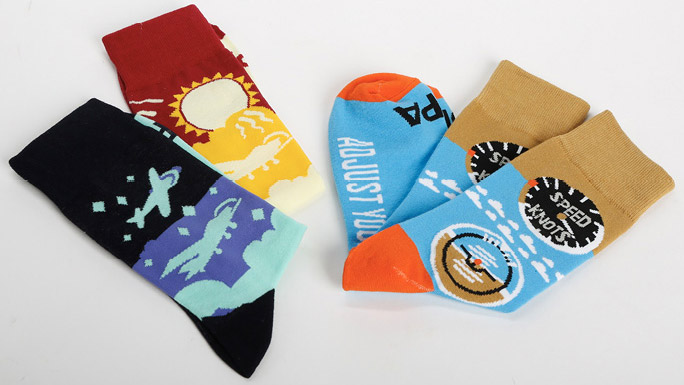Membership: New from the store
Great gear from AOPA

Wear your passion for flying with pride and share your support for the association with apparel and products uniquely created for AOPA. We have clever T-shirts and durable outerwear; hats and accessories with the AOPA logo; and one-of-a-kind accessories such as our aviation-themed face coverings, blankets, and lapel pins. We even offer a bandana for your favorite flying companion—your dog (check out Skyler’s bandana in “Dog & Plane,” p. 32).
Packing it in
 Get organized for your next trip with functional packing cubes in colorful aviation designs from the AOPA Pilot Gear store. Lightweight ripstop nylon packing cubes help organize everything you put into your suitcase. Each cube has a built-in stuff pouch to keep it tucked away, yet handy when you need it. The set consists of three packing cubes. The small cube features a floatplane in the water and measures 10 inches by 8 inches. The medium cube features a Piper PA–11 on tundra tires in the backcountry and measures 15 inches by 10 inches. The large cube features a Daher TBM 930 in the city and measures 21 inches by 15 inches. All the packing cubes are 3.5 inches tall. Set of three is $55.
Get organized for your next trip with functional packing cubes in colorful aviation designs from the AOPA Pilot Gear store. Lightweight ripstop nylon packing cubes help organize everything you put into your suitcase. Each cube has a built-in stuff pouch to keep it tucked away, yet handy when you need it. The set consists of three packing cubes. The small cube features a floatplane in the water and measures 10 inches by 8 inches. The medium cube features a Piper PA–11 on tundra tires in the backcountry and measures 15 inches by 10 inches. The large cube features a Daher TBM 930 in the city and measures 21 inches by 15 inches. All the packing cubes are 3.5 inches tall. Set of three is $55.
Ask AOPA
Just for fun
You can learn new skills—and hone the basics—by taking on a different kind of flying
By Craig Brown
Q: Would you recommend a pilot receive training in, say, a tailwheel airplane, just for fun? I have no practical use for it in my day-to-day flying career, but is extra training a good idea?
A: Absolutely! Any type of training a pilot can receive is going to benefit his or her flying by adding new skills or challenges.
Let me tell you about a student I had many years ago. Let’s call him Paul. He was a captain for a major airline, flying a McDonnell Douglas MD–80. Every day he went to work he flew from Washington, D.C., to Dallas and back. Several times a week. Many times a month. You can imagine Paul knew the route inside and out and was seldom challenged on his flights. According to Paul, he felt more like a bus driver than an airline pilot.
One day Paul showed up at my flight school and said he wanted to take some aerobatic training. I asked him what he did for a living. I understood at that moment why he was here. Knowing that he never had, I asked him if he ever banked that MD–80 more than 30 degrees. His answer confirmed what I thought. I told him that we were, indeed, going to have a good time.
Paul really got hooked on inverted flying. Every time we went out, he just had to roll inverted to see how long he could maintain it. To him, that was the greatest challenge in aerobatics—seeing just how long he could fly inverted while holding heading and altitude, or performing precise turns left and right. That was his airline discipline, but the maneuvers were pure general aviation.
Paul had a blast and learned some new skills that would last a lifetime and also had practical applications if he ever found himself in an emergency situation. My advice? Go for it!
pic.aopa.org
Craig Brown is a senior aviation technical specialist in the AOPA Pilot Information Center.


